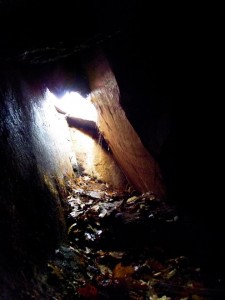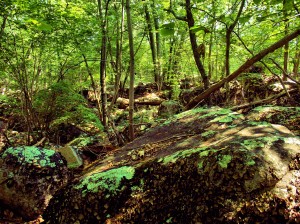 In Rhode Island there is a rocky hill known as Queen’s Fort. It was an Indian fort that was occupied by Narragansett Indians that survived the battle in the Great Swamp, and chose not to leave RI. It lives on a hill covered with glacial erratics. With that natural feature alone, this was a fantastic place for a fort. Somewhere hidden in this rugged landscape is a cave know as Queen Quaiapens Chamber.
In Rhode Island there is a rocky hill known as Queen’s Fort. It was an Indian fort that was occupied by Narragansett Indians that survived the battle in the Great Swamp, and chose not to leave RI. It lives on a hill covered with glacial erratics. With that natural feature alone, this was a fantastic place for a fort. Somewhere hidden in this rugged landscape is a cave know as Queen Quaiapens Chamber.
Posted in Archaeological, Cave, Geological, Historical, Ruins, Subterranean by Michael with 4 comments.
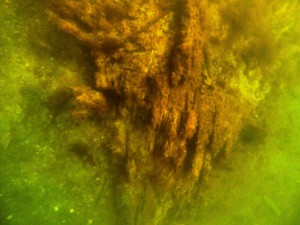
The Stern
On January 1st, Richard and I fabricated a special rigging for the GoPro using PVC and a rail mount. The new mount would allow us to secure the camera over the side of the kayak, and position it facing in any direction using the two universal joints.
With the new camera mount, we went for a second visit to the remains of the 1873 British bark Bessie Rogers on Saturday. With the camera attached to the kayak, facing down and set to take photos every seconds, I paddled over to the wreck.
I broke up the area into four lanes. Once a lane was completed, since the camera was mounted on the starboard side, I turned around and repeated the lane. The entire wreck took about a half hour or more to cover. In the end we collected over 2000 photos
Posted in Archaeological, Historical, Marine by Michael with no comments yet.
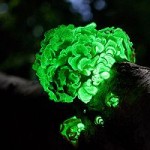 Before the mid-1800s, most people dwelled in places where the night often brought complete blackness. If a person ventured outside at night, there would be times when they stumbled on a world of luminous organisms living in our forests and bays. Some of these instances could be frightening and have been the origin of local lore.
Before the mid-1800s, most people dwelled in places where the night often brought complete blackness. If a person ventured outside at night, there would be times when they stumbled on a world of luminous organisms living in our forests and bays. Some of these instances could be frightening and have been the origin of local lore.
We now live in an age of illumination and have lost touch with the strange world of bioluminescence. The dark conditions needed are now eliminated by the light pollution around us. Because of this, most people are only aware of one of the six members of this microcosm, the firefly.
In 2015 we plan to hunt down all of New England creatures that exhibit bioluminosity. Though we will start with the familiar firefly, our journey will take us from the sea to the dark swamps and forests. Using our OpenROV and being patient explorers, we hope to capture photos and images of these amazing organisms in their natural habitats.
Posted in Botany, Historical, Marine, Wildlife by Michael with 1 comment.
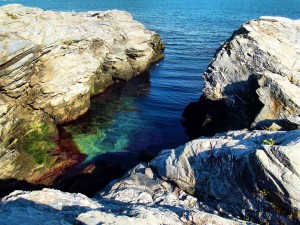 Sept 27th we made a second visit to Beavertail and it was a good day. We were able to look at a manuscript concerning the schooner H.F. Payton and its demise. Following our visit to the historical society library we headed down to the southern point to once again walk the shore during low time. With the new information in hand we felt confident we’d find the block.
Sept 27th we made a second visit to Beavertail and it was a good day. We were able to look at a manuscript concerning the schooner H.F. Payton and its demise. Following our visit to the historical society library we headed down to the southern point to once again walk the shore during low time. With the new information in hand we felt confident we’d find the block.
As we waited for low tide to arrive, we reexamined the areas we had already searched. We also took the time to test a new underwater filer we had just gotten for the GoPro.
At the peak of low tide we began where we had started on on Sept 21st and proceeded south this time. About a quarter mile into our quest, we found the blocks.
Posted in Archaeological, Historical by Michael with no comments yet.
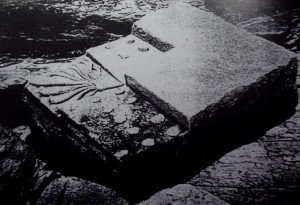 Ms Dreadful and I headed down to Conanicut Island to inspect the shore where the schooner H F Payton sank in 1859. It had been carrying 140 cut granite stones with unique Fleur-d-Lis design carved into them. Some thought the design resembled a squid, and referred to them as the granite monsters. The H F Payton had been headed for Washington D.C. and the stones were thought to be intended to be used for a mausoleum.
Ms Dreadful and I headed down to Conanicut Island to inspect the shore where the schooner H F Payton sank in 1859. It had been carrying 140 cut granite stones with unique Fleur-d-Lis design carved into them. Some thought the design resembled a squid, and referred to them as the granite monsters. The H F Payton had been headed for Washington D.C. and the stones were thought to be intended to be used for a mausoleum.
The 1938 hurricane hurled some of the granite monsters up on the shore, and in the past you could find a few at low tide. We were trying to locate what remains of them. Our gaol was to try to confirm the location of these blocks. Once we’ve accomplished that we’ll then start working on acquiring an OpenRov. With the ROV we hope to find where the rest of the blocks and the other cargo of the H F Payton now rests below the waves.
Posted in Historical by Michael with no comments yet.
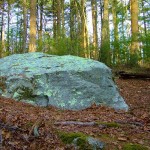 New England has many rocks with mysterious and cryptic messages scaring their surface. The Narragansett Basin is th host of many of them. One of the more recognized is ‘Dighton Rock’ located along Route 24 in Dighton Massachusetts . Also off of 24, buried in the forests of East Bridgewater , is a strange rock not many are aware of. In this case, the words can clearly be read by anyone and the person scribed them is not a mystery at all. What inspired this man to sprawl these words on a boulder is what puzzles me.
New England has many rocks with mysterious and cryptic messages scaring their surface. The Narragansett Basin is th host of many of them. One of the more recognized is ‘Dighton Rock’ located along Route 24 in Dighton Massachusetts . Also off of 24, buried in the forests of East Bridgewater , is a strange rock not many are aware of. In this case, the words can clearly be read by anyone and the person scribed them is not a mystery at all. What inspired this man to sprawl these words on a boulder is what puzzles me.
Many years ago we had heard that there was an interesting rock in the town of East Bridgewater . The rock itself is the standard type of New England bedrock sitting on a lonely hillside in the middle of nowhere. What makes this rock so unusual is the poem that was brazened onto its side. Also on the lower left was a small notch with three lines of Roman Numerals carved marking the year it was created, 1862. The man responsible for this granite enigma was Reverend Timothy Otis Paine. Rev. Paine was a student of poetry, sculpting and oriental languages and a native of Winslow Maine. He moved to Bridgewater where he became the minister of the Swedenborgian Church in Elmwood. At his time he was considered to be the most educated Egyptologist in America . In 1897, over 30 years after he chiseled the poem into stone, a volume of his poetry was published. For a man of such notoriety, I was surprise to find very little written about his life in Bridgewater . We can only assume there is much more about this interesting man waiting to be uncovered.
Posted in Historical by Michael with no comments yet.
 Almost a year ago we had found the counterfeiters den that had been lost for close to 100 years. We promised that we would share the full story behind the Den once our research was complete. Though the story is still not complete and there is much more research to be done, we felt we would share how much we have so far. We have withheld names and particular details of the story because we are currently working with members of the local government to protect it. We confirmed that the den is on private property and we are trying to arrange a conservation easement. For now, the den should be considered off limits. Soon we hope to meet with the land owners to begin discussions. We hope to develop a good relationship with them so that the den can be protected and possibly accessible in the future.
Almost a year ago we had found the counterfeiters den that had been lost for close to 100 years. We promised that we would share the full story behind the Den once our research was complete. Though the story is still not complete and there is much more research to be done, we felt we would share how much we have so far. We have withheld names and particular details of the story because we are currently working with members of the local government to protect it. We confirmed that the den is on private property and we are trying to arrange a conservation easement. For now, the den should be considered off limits. Soon we hope to meet with the land owners to begin discussions. We hope to develop a good relationship with them so that the den can be protected and possibly accessible in the future.
The History of “The Lost Counterfeiters Den”
In the fall of 2012, Ms Dreadful and I decided to turn our attention back to our long-term project of hunting down seldom-visited or long-forgotten caves in New England. We had accumulated a long list of caves by digging through our library of historic books and documents, and many visits to the local historical archives. This year we read about a cave that we had seen mentioned in the past. We had been involved in another project and neglected to make note of it. To avoid repeating the same mistake, we thought now was the best time to act.
At a rocky ridge on the south side of a ravine, deep in the forests of the New England, a band of counterfeiters were forging coins. Tradition says that at this same location there was a small cave they used to hide their tools and money. The cave was known by locals as Counterfeiters’ Den, and the last time it had been visited was the early 1920s. This cave was entered from above through a triangular opening that could be hidden by a rock slab that fit the opening. With little effort, it could be so well concealed in the forest landscape that only the men of this unscrupulous enterprise would ever be aware of its existence.
Posted in Cave, Geological, Historical, Subterranean by Michael with 27 comments.

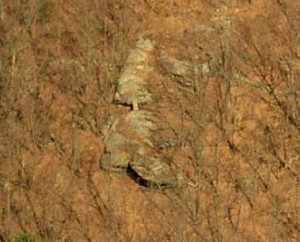 In Massachusetts there is a cave known as Mag’s or Margaret’s Cave. This cave is believed to be an important part of Rhode Island history. Lore also connects it to the nearby Devil’s Rock, claiming that two rocks near the cave are the devil and his wife turned to stone. It surprised me to find that this historically interesting cave appears to be a secret to most of the community.
In Massachusetts there is a cave known as Mag’s or Margaret’s Cave. This cave is believed to be an important part of Rhode Island history. Lore also connects it to the nearby Devil’s Rock, claiming that two rocks near the cave are the devil and his wife turned to stone. It surprised me to find that this historically interesting cave appears to be a secret to most of the community.
In October 1635, Roger Williams was tried by the General Court of Massachusetts and convicted of sedition and heresy. They felt that he was spreading “diverse, new, and dangerous opinions” and banished him from the state. His actual banishment was delayed due to the fact that he was ill, and winter was near. He was allowed the delay provided he ceased his agitation. Roger Williams did not cease, so in January 1636 the sheriff came to arrest him only to find he already had slipped away three days before, during a blizzard. He made the difficult journey of 105 miles from Salem to the head of Narragansett Bay during difficult winter weather. According to tradition, Roger Williams was very ill, and the local Wampanoags offered him shelter. They took him to the winter camp of their chief sachem, Massasoit. Here at what is now known as Margret’s Cave, Massasoit and another Indian known as Margaret cared for him for three month and nursed him back to health.
Posted in Cave, Geological, Historical by Michael with 4 comments.
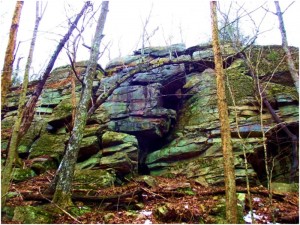
A ledge of well foliated granite gneiss.
Squaw Rock and a nearby cave were mentioned briefly by Clay Perry in New England’s Buried Treasure. Information on the exact location of its caves’ and history of Squaw Rock was very limited. The most detailed record was found in Larned’s A Modern History of Windham County Connecticut, published in 1874. The book claims that Squaw Rock, “was a name supposed to have been given by early Indian Inhabitants.” It goes on to say that during the wars between tribes, the caves were used as a place to hide the “squaws and papooses.” Some local historians claim that it eventually became the location where the remnants of the tribe lived, until there was finally only a lone squaw for whom the cave was named.
The caves lie in a talus at the base of a nearly 75 foot high ledge that runs north for over 300 feet. In the 1700s it was a popular picnic spot for families. The locals gave the caves names like ‘The Devil’s Kitchen”, “Old Ladies’ Arm Chair”, and “Old Ladies’ Stove”. Other features of the talus were called “The Dancing Floor”, “Fiddler’s Stand” and “Pulpit Rock”. Larned speaks of a room with three passages. The first passage was from outside, the second lead to another chamber and a third “leads to an unknown distance.” She goes on to say, “It has been explored until the light carried went out, indicating danger if the parties went further.”
Posted in Cave, Geological, Historical, Subterranean by Michael with 4 comments.
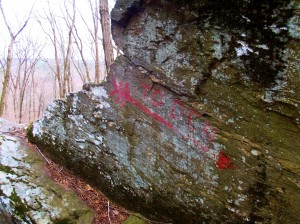
An arrow showing the way to the Dragon’s Hole
New England has many Wildlife Management Areas. Though they highlight great sights, often there are long forgotten landmarks and geological curios hidden in their dark recesses. Over time the trails to them and mention on the maps fades away, and they are lost into history.
This past weekend we visited one of these landmarks hidden in the forests of Connecticut. We had first heard of this cave in a book about places to visit that was published in the 1930s by the state planning board. Since the 1700s it was referred to as Dragon’s Hole but eventually was also referred to as Devil’s Den. Though it was a popular feature in the 1800s, now it was once again absorbed back into the wild.
Devil’s Den was a common name used by colonial settlers concerning caves that gave the reason to suspect activity of a dark force. Dragon’s hole was said to be one of those cave. It was said that strange noise and lights would be seen coming from the grotto it lives within. Some believed that these tales were just folklore created by mothers trying to protect their children from the hazards of this wild terrain.
Posted in Cave, Geological, Historical, Subterranean by Michael with 1 comment.






